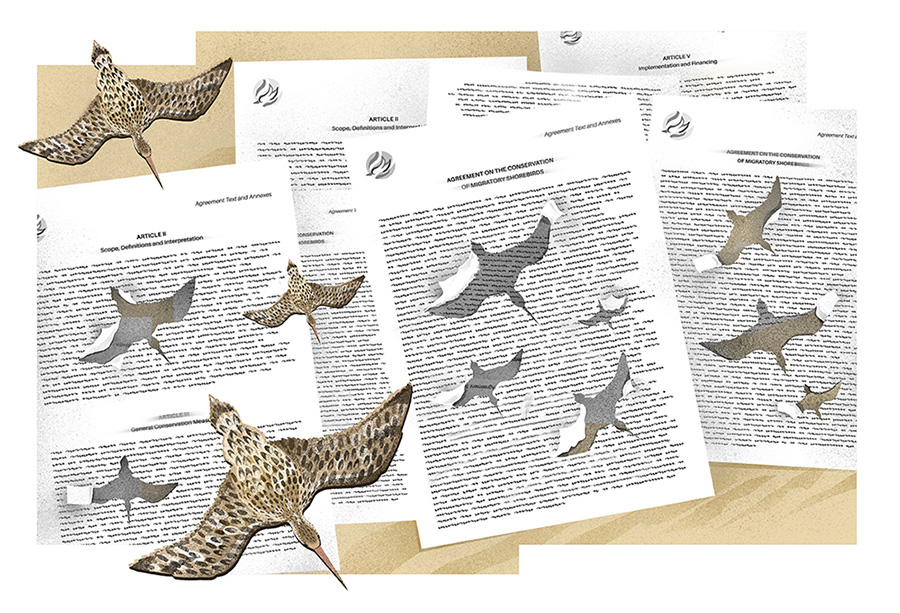Feature photo: Human-dolphin cooperation at Tramandaí Inlet, southern Brazil, CC: Botos da Barra Project
In a few African cultures, people look for wild honey with the help of greater honeyguides (Indicator indicator). These birds lead the way to wild bees’ nests, then eat the wax that people leave after the honey harvest. In a similar way, groups of fishers in Myanmar and Brazil cooperate with wild dolphins to catch fish: the dolphins drive fish towards nets on the shoreline, improving the overall catch. Human-honeyguide and human-dolphin cooperation are the only remaining examples of cooperation between people and wild animals known to scientists. They were once far more widespread, but due to cultural and ecological change they are now at risk of being lost.

In our recent article in Conservation Letters, a large, multidisciplinary team of 41 authors from 18 different countries reviewed the benefits brought by these fascinating and rare cases of human-wildlife cooperation, as well as the threats and unique safeguarding challenges they face.

For the people involved, human-wildlife cooperation leads to more and better harvests (that is, honey or fish), compared to similar artisanal harvesting without the help of a wildlife partner. These resources provide food security and boost income. Cooperating with wildlife also brings important cultural benefits to people, such as a sense of identity, belonging, and recreation. For the wildlife partner, cooperation with humans increases their access to food: bees’ wax and larvae for honeyguides, and fish for dolphins. These benefits to both partners make these cases of human-wildlife cooperation worth protecting. Both human-honeyguide and human-dolphin cooperation occur at multiple locations which differ in local human cultural practices. Wildlife partners adjust their behaviour to this variation in human culture, leading to a complex mosaic of wildlife populations that differ in the way they cooperate and communicate with humans, thereby increasing biodiversity. However, these animal populations often have cultures of their own: human culture affects animal culture, and vice versa!

These unique cases of human-wildlife cooperation face a specific set of conservation challenges. They need four components to function: a motivated human partner; a motivated wildlife partner; a suitable environment; and compatible knowledge and skills to engage in the interaction. Our review highlights that a mix of environmental and cultural changes can threaten these four components: loss of interest by the human partner due to economic reasons or displacement, for example by the exclusion of people from conservation areas in Africa or urban development in southern Brazil; wildlife numbers decreasing due to degraded habitats; scarcity of prey sources, often because of human impacts on the environment; and fading knowledge or skills in the younger individuals, of both people and their wildlife partners.

In decades and centuries gone by, people have also cooperated with orcas to kill whales, and with wolves to hunt large mammals, but these cases of human-wildlife cooperation were wiped out by ecological and cultural change. This is a vivid reminder that human-honeyguide and human-dolphin cooperation are also at risk of decline and loss.
To safeguard the remaining cases, our review provides guidelines for developing conservation measures tailored to local conditions. We recommend enforcing legal protection of cooperative sites, while supporting local communities’ participation in human-wildlife cooperation. Human interest can be maintained and encouraged by campaigns to affirm the value of local practices. This could be achieved by raising outsider awareness, and by financial incentivisation including eco-tourism and elevated sale prices for fish or honey harvested through human-wildlife cooperation. The wildlife partner’s participation may rely on a limited number of individuals that act as knowledge repositories and ‘demonstrators’, and conservation work should focus on identifying and protecting these high-value individuals. Finally, we need to promote and archive local ecological and cultural knowledge, both to ensure that interspecies knowledge remains compatible, and to better our understanding of these interactions and their threats.
Our review raises awareness of the unique value of human-wildlife cooperation and highlights that conservation efforts need to consider not only human and animal cultures, but also the interaction between them.
We are grateful to our review co-authors, to the communities with whom we cooperate in our research, to the Niassa Special Reserve in Mozambique, and to the European Research Council for funding our work. Read more about our research on human-honeyguide cooperation on www.AfricanHoneyguides.com.
Original paper:
van der Wal, J. E. M., C. N. Spottiswoode, N. T. Uomini, M. Cantor, F. G. Daura-Jorge, A. I. Afan, M. C. Attwood et al. 2022 Safeguarding human-wildlife cooperation. Conservation Letters 15(4): e12886.






